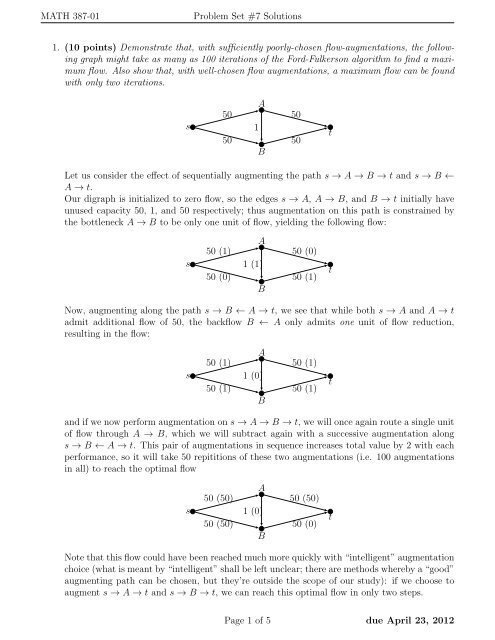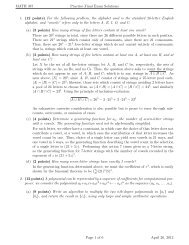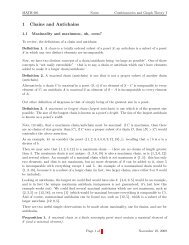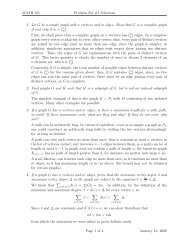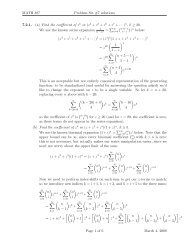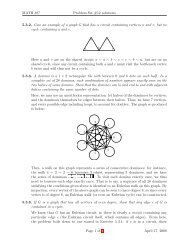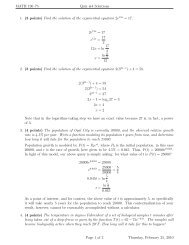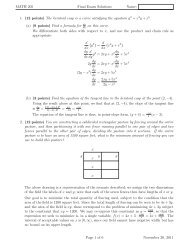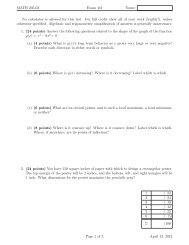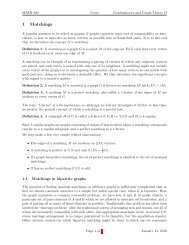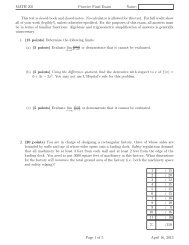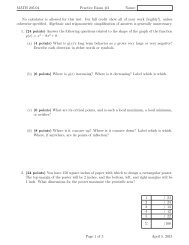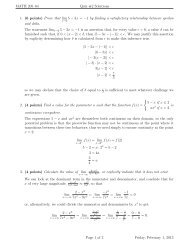MATH 387-01 Problem Set #7 Solutions 1. (10 points) Demonstrate ...
MATH 387-01 Problem Set #7 Solutions 1. (10 points) Demonstrate ...
MATH 387-01 Problem Set #7 Solutions 1. (10 points) Demonstrate ...
You also want an ePaper? Increase the reach of your titles
YUMPU automatically turns print PDFs into web optimized ePapers that Google loves.
<strong>MATH</strong> <strong>387</strong>-<strong>01</strong><br />
<strong>Problem</strong> <strong>Set</strong> <strong>#7</strong> <strong>Solutions</strong><br />
<strong>1.</strong> (<strong>10</strong> <strong>points</strong>) <strong>Demonstrate</strong> that, with sufficiently poorly-chosen flow-augmentations, the following<br />
graph might take as many as <strong>10</strong>0 iterations of the Ford-Fulkerson algorithm to find a maximum<br />
flow. Also show that, with well-chosen flow augmentations, a maximum flow can be found<br />
with only two iterations.<br />
s<br />
50<br />
50<br />
1<br />
A<br />
B<br />
50<br />
50<br />
t<br />
Let us consider the effect of sequentially augmenting the path s → A → B → t and s → B ←<br />
A → t.<br />
Our digraph is initialized to zero flow, so the edges s → A, A → B, and B → t initially have<br />
unused capacity 50, 1, and 50 respectively; thus augmentation on this path is constrained by<br />
the bottleneck A → B to be only one unit of flow, yielding the following flow:<br />
s<br />
50 (1)<br />
50 (0)<br />
A<br />
1 (1)<br />
B<br />
50 (0)<br />
50 (1)<br />
t<br />
Now, augmenting along the path s → B ← A → t, we see that while both s → A and A → t<br />
admit additional flow of 50, the backflow B ← A only admits one unit of flow reduction,<br />
resulting in the flow:<br />
s<br />
50 (1)<br />
50 (1)<br />
A<br />
1 (0)<br />
B<br />
50 (1)<br />
50 (1)<br />
t<br />
and if we now perform augmentation on s → A → B → t, we will once again route a single unit<br />
of flow through A → B, which we will subtract again with a successive augmentation along<br />
s → B ← A → t. This pair of augmentations in sequence increases total value by 2 with each<br />
performance, so it will take 50 repititions of these two augmentations (i.e. <strong>10</strong>0 augmentations<br />
in all) to reach the optimal flow<br />
s<br />
50 (50)<br />
50 (50)<br />
A<br />
1 (0)<br />
B<br />
50 (50)<br />
50 (0)<br />
t<br />
Note that this flow could have been reached much more quickly with “intelligent” augmentation<br />
choice (what is meant by “intelligent” shall be left unclear; there are methods whereby a “good”<br />
augmenting path can be chosen, but they’re outside the scope of our study): if we choose to<br />
augment s → A → t and s → B → t, we can reach this optimal flow in only two steps.<br />
Page 1 of 5 due April 23, 2<strong>01</strong>2
<strong>MATH</strong> <strong>387</strong>-<strong>01</strong><br />
<strong>Problem</strong> <strong>Set</strong> <strong>#7</strong> <strong>Solutions</strong><br />
2. (<strong>10</strong> <strong>points</strong>) Find a digraph and a flow thereon which could not be improved by naïve flow<br />
expansion (i.e. simply attempting to add flow along some path), but which has value only<br />
one-third (or less) of the maximum possible flow.<br />
A simple such example appears below; it can be generalized to produce arbitrarily bad flows.<br />
Every edge has capacity 1, and capacities are not displayed for simplicity. The utilized edges<br />
(which are used to full capacity) are drawn in heavier lines:<br />
s<br />
u 1<br />
v 1<br />
u 2<br />
v 2<br />
u 3<br />
v 3<br />
t<br />
No naïve flow augmentation is possible, since there are no under-capacitiy edges between the<br />
u i and v i vertices (note that there are several Ford-Fulkerson augmentations possible, such as<br />
s → u 2 ← v 1 → t). This flow has a value of 1, but a value-3 flow could be constructed on this<br />
graph easily by using each of the paths s → u i → v i → t.<br />
By adding additional vertex-pairs and switchbacks, it is easy to extend this into an example<br />
where a naïve-maximal flow is only an nth of the actual maximum flow for any value of n.<br />
3. (<strong>10</strong> <strong>points</strong>) 6 people (A, B, C, D, E, and F) are to be assigned to 4 committees (W, X, Y, and<br />
Z). Each person can serve on no more than 2 committees, and each committee should have 3<br />
people on it. Below is a table indicating which people are eligible to serve on which committees:<br />
W X Y Z<br />
A √ √ √ √<br />
B √ √<br />
C √ √<br />
√ √ √<br />
D<br />
√ √<br />
E<br />
√ √<br />
F<br />
(a) (5 <strong>points</strong>) Produce a digraph with capacities whose flows would represent committee assignments.<br />
This is an assignment problem, so we have flows from individuals to assignments, from the<br />
source to individuals, and from the assignments to the sink. Since each person’s committeeservice<br />
fills one gap, the edges from individuals to assignments have capacity 1; since each<br />
person can serve on up to 2 committees, the capacity from the source to each person<br />
(i.e., the amount of outflow the person can possibly deliver to various assignments) is 2,<br />
while since each committee ought to have 3 members, the capacity from each committee<br />
to the sink (i.e., the amount of inflow the committee can possibly receive from various<br />
individuals) is 3, and flow from individuals to committees represents assignment to that<br />
committee. The digraph is depicted below, with edges of capacity 1 left unlabeled for<br />
simplicity:<br />
Page 2 of 5 due April 23, 2<strong>01</strong>2
<strong>MATH</strong> <strong>387</strong>-<strong>01</strong><br />
<strong>Problem</strong> <strong>Set</strong> <strong>#7</strong> <strong>Solutions</strong><br />
A<br />
W<br />
2<br />
2<br />
2<br />
B<br />
C<br />
X<br />
3<br />
3<br />
s<br />
2<br />
2<br />
2<br />
D<br />
E<br />
Y<br />
3<br />
3<br />
t<br />
F<br />
Z<br />
(b) (5 <strong>points</strong>) Find a maximum flow on your digraph. What does this flow’s value tell you<br />
about your committee assignment?<br />
A maximum flow is exhibited below; for simplicity, edges of capacity 1 are unlabeled, and<br />
are drawn with heavier lines to indicate flow and lighter lines if not used:<br />
A<br />
W<br />
2 (2)<br />
B<br />
3 (3)<br />
2 (2)<br />
2 (2)<br />
C<br />
X<br />
3 (3)<br />
s<br />
2 (2)<br />
2 (1)<br />
D<br />
2 (2)<br />
E<br />
Y<br />
3 (3)<br />
3 (2)<br />
t<br />
F<br />
Z<br />
This flow is not unique and there are many other flows of equal value. That this flow is<br />
of maximum value can be easily seen by attempting to find a Ford-Fulkerson augmenting<br />
path; such a path would need to start with the step along the underutilized edge s → F ,<br />
and then along the underutilized edge F → Y , and then along a backflow edge Y ← E,<br />
Y ← C, or Y ← B, but from there no further progress can be made, so there is no<br />
augmenting path.<br />
The value of this flow is 11, which is less than we would expect with a sound committee<br />
assignment, in which each of the 6 individuals and 4 committees see full service with a<br />
total of 12 assignments. However, maximality of the flow assures us that our failure to<br />
Page 3 of 5 due April 23, 2<strong>01</strong>2
<strong>MATH</strong> <strong>387</strong>-<strong>01</strong><br />
<strong>Problem</strong> <strong>Set</strong> <strong>#7</strong> <strong>Solutions</strong><br />
assign everyone perfectly was not a result of foolishly suboptimal assignment on our part:<br />
there is in fact no flow of value 12 and this flow, which leaves committee Z unfilled and<br />
member F underutilized, is the best we can do under our constraints.<br />
4. (<strong>10</strong> <strong>points</strong>) You are building circular bracelets with 6 beads on them; you have beads in red,<br />
yellow, and green. You want to have at least one bead of each color on every bracelet, and two<br />
bracelets are considered to be identical if one can be produced by flipping or rotating the other.<br />
How many different bracelets are possible?<br />
We may consider our beads as residing at the vertices of a regular hexagon for symmetry<br />
analysis-purposes. There are 12 rotation and reflection symmetries of a regular hexagon, which<br />
we can divide into six classes: the identity e; the clockwise and counterclockwise 60 ◦ rotations<br />
r and r 5 ; the clockwise and counterclockwise 120 ◦ rotations r 2 and r 4 ; the 180 ◦ rotation r 3 ; the<br />
three flips across edge-to-edge axes, and the three flips across vertex-to-vertex axes.<br />
Our universe of possible colorings of a fixed hexagon is given by the surjective mappings from<br />
the vertices to the colors: using inclusion-exclusion techniques, we see that there are 3 6 −3·2 6 +<br />
3 · 1 6 = 540 such. Since every coloring is invariant under the identity mapping, Inv(e) = 540.<br />
In order to be invariant under r or r 5 , every single vertex would need to be the same color;<br />
the number of invariants of this operation is thus the number of surejctive mappings from a<br />
set consisting of a single collection of vertices to the three colors. We could enumerate these<br />
mappings via inclusion-exclusion as 3 1 − 3 · 2 1 + 3 · 1 1 = 0; however, it is equally valid to<br />
simply observe that such a surjection is impossible and that there are thus zero such; either<br />
way, Inv(r) = Inv(r 5 ) = 0.<br />
Likewise, r 2 and r 4 map vertices in two 3-cycles, so each 3-cycle must be monochromatic to be<br />
invariant, so here we are attempting to color 2 collections of vertices surjectively with 3 colors.<br />
Again, we might either explicitly calculate 3 2 −3·2 2 +3·1 2 = 0 or simply note the impossibility<br />
of such a surjection to determine that Inv(r 2 ) = Inv(r 4 ) = 0.<br />
r 3 swaps opposite vertices, so invariance under r 3 requires that each vertex be the same color as<br />
its antipode; that is, each pair of opposite vertices must be the same color, so we are surjectively<br />
mapping 3 pairs of vertices onto the 3 colors. Here this is possible, and we might explicitly<br />
determine 3 3 −3·2 3 +3·1 3 = 6 or note that a surjective mapping from a set to a set of the same<br />
size is a bijection, and there are 3! bijective mappings between sets of size 3; either analysis<br />
yields Inv(r 3 ) = 6.<br />
Considering the three edge-fixing swaps, which we might call f, fr 2 , and fr 4 , they too map<br />
pairs of vertices onto each other, yielding the same analysis as in the previous paragraph, so<br />
Inv(f) = Inv(fr 2 ) = Inv(fr 4 ) = 6.<br />
The vertex-fixing swaps, on the other hand, fix two vertices, which could be any color, and<br />
swap two pairs, each of which must be monochromatic to be invariant, so Inv(fr) = Inv(fr 3 ) =<br />
Inv(fr 5 ) = 3 4 − 3 · 2 4 + 3 · 1 4 = 36.<br />
Now we may assemble all these invariants to find the number of classes of hexagons equivalent<br />
under these 12 transformations:<br />
∑<br />
g∈D 6<br />
Inv(g)<br />
|D 6 |<br />
so there are 56 distinct bracelets.<br />
=<br />
540 + 2 · 0 + 2 · 0 + 6 + 3 · 6 + 3 · 36<br />
12<br />
5. (5 point bonus) The faces of a cube are to be painted red, blue, and green; each color can be<br />
used as many times as desired or not at all. Two cube-paintings are considered to be identical<br />
if one is a rotation of the other. How many different ways are there to paint the cubes? Do not<br />
brute-force this problem!<br />
= 56<br />
Page 4 of 5 due April 23, 2<strong>01</strong>2
<strong>MATH</strong> <strong>387</strong>-<strong>01</strong><br />
<strong>Problem</strong> <strong>Set</strong> <strong>#7</strong> <strong>Solutions</strong><br />
There are 24 rotations of a cube, which fall into 5 classes: the identity e; rotations of 90 ◦ around<br />
an axis through a pair of opposite faces (of which there are six in total: three pairs of faces,<br />
and the choice of a clockwise or counterclockwise rotation, for 3 · 2 = 6) which we shall denote<br />
r f ; rotations of 180 ◦ around an axis through a pair of opposite faces (of which there are three<br />
in total, one for each of the three pairs of faces) which we shall denote rf 2 ; rotations of 60◦<br />
around an axis through a pair of opposite vertices (of which there are eight in total: four pairs<br />
of vertices, and the choice of a clockwise or counterclockwise rotation, for 4 · 2 = 8) which we<br />
shall denote r v ; and rotations of 180 ◦ around an axis through a pair of opposite edges (of which<br />
there are six in total, one for each of the six pairs of edges). The invariance information of a<br />
coloring of faces of the edges is presented in the table below:<br />
Rotation Multiplicity Number of cycles Invariants<br />
e 1 6 3 6 = 729<br />
r f 6 3 3 3 = 27<br />
rf 2 3 4 3 4 = 81<br />
r v 8 2 3 2 = 9<br />
r e 6 2 3 3 = 27<br />
so using Burnside’s Theorem, the number of equivalence classes of the cube under the rotation<br />
group (also called the octahedral symmetry group O) is:<br />
∑<br />
g∈O Inv(g)<br />
|O|<br />
so there are 57 different cube-colorings.<br />
=<br />
729 + 6 · 27 + 3 · 81 + 8 · 9 + 6 · 27<br />
24<br />
= 57<br />
Life is an even-numbered problem.<br />
—Educational folk wisdom<br />
Page 5 of 5 due April 23, 2<strong>01</strong>2


